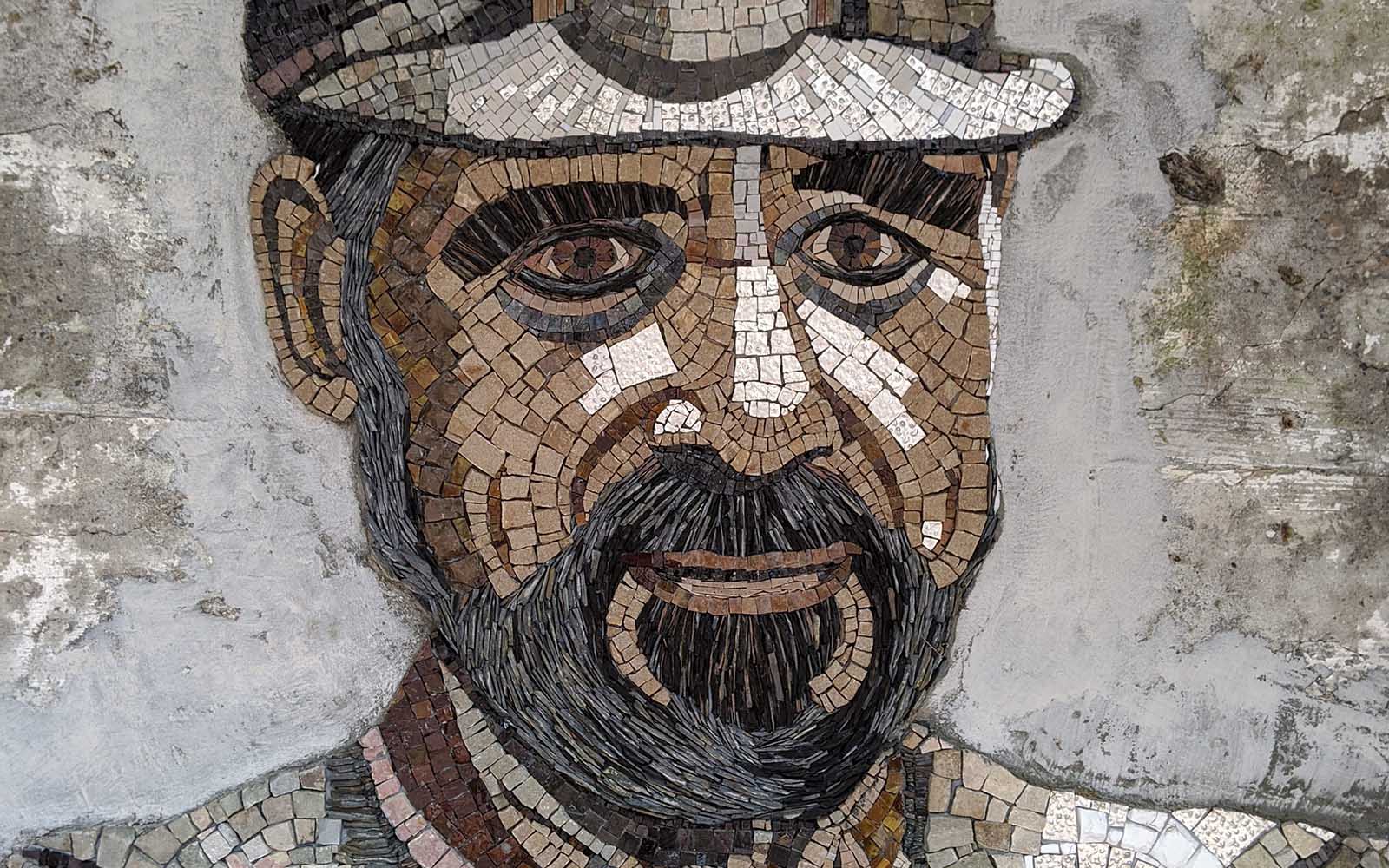
Rachel Sager’s The Ruins Project, Part Three
This week we are sharing the final of three articles by Rachel Sager reflecting on The Ruins Project, a long-term collaborative mosaic art installation amid the ruins of a former coal mine in Fayette County, Pennsylvania. Rachel Sager operates the Sager Mosaics Studio, which is located near mile marker 104 on the Great Allegheny Passage and adjacent to The Ruins Project, which represents the rebirth of abandoned American coal country into a spiritual and artistic pilgrimage and destination for adventure seekers and lovers of art and history.
In her first article, Rachel introduced the site and the project and outlined her first rule for collaborators contributing artworks—they must Honor What Was. Rachel set in place a trio of rules the first year, before any of the collaborative art was begun. The rules apply to everyone. The artists use them to make mosaic in ways that preserve the delicate balance of her vision. The rules also help visitors to appreciate the story that is unfolding on deeper, more meaningful levels.
Then, for her next article, she reflected on the second rule—to build relationships with the raw materials. The process reflects a sense of place—exploring creativity, storytelling, and mosaic traditions.
Today, for her final submission, Rachel considers an essential aesthetic technique—the use of andamento or the way of the line in the construction of the artworks. Beyond a principle of the craft, the use of andamento takes on a meaning that is both grounding and transcendent for Rachel Sager. Join her in understanding the balance of what she refers to as “walking the line.”
By Rachel Sager, Guest Contributor
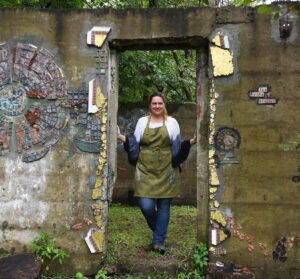
Rachel Sager
Walking the Line at The Ruins—Exploring the Language of Mosaic
There is a fancy word in mosaic land that holds a kind of sovereignty over all other words.
It’s stronger than tesserae, which means each individual square of stone. It’s stronger than material, which can mean glass or ceramic or pebbles or shells.
It’s even stronger than composition, which is crucial for all the arts.
It is the ABC of mosaic. Some describe it as the language that mosaicists speak.
It can be described as flow. And sometimes as pathways.
I have taken to calling the line. And I ask all artists at The Ruins to walk the line.
(The greatest respect goes to Johnny Cash for gifting the world with those three brilliant words.)
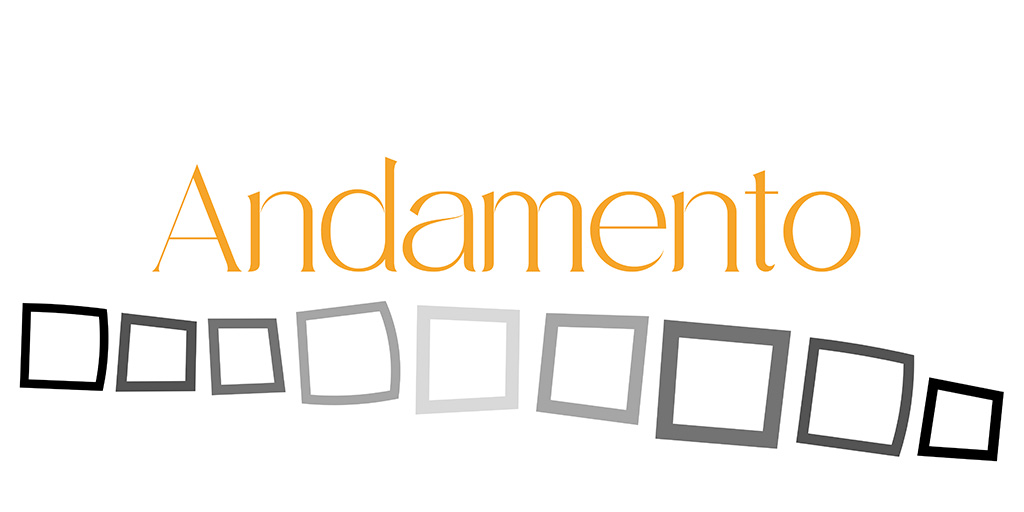
Andamento
But you don’t see andamento in all mosaic; only the kind that is steeped in the old ways. Let me take you back about one thousand years, give or take.
The mosaicists who came before us built an impressive infrastructure of rules (guidelines) that enabled them to tell their stories. When we see Greek, Roman, and Byzantine mosaic work, we are looking at centuries of cultural knowledge that evolved slowly and specifically to perfect the image. Whether that image was the human form, a sea monster, or a mountain landscape, the elegant lines made them all come alive.
Shape, size, angle, placement, direction, and space are some of elements that make up these rules. I teach a contemporary version of them in my popular online course, Intuitive Andamento.
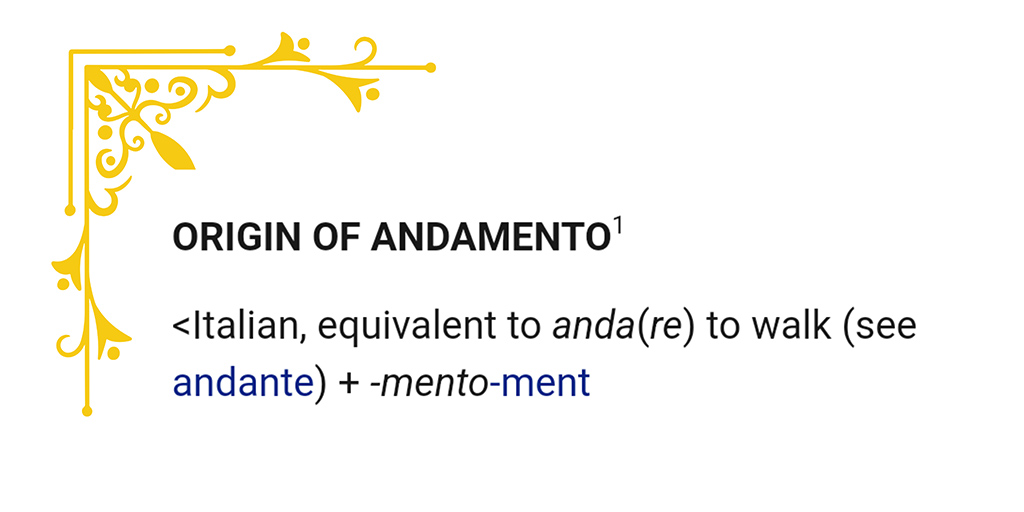
For those who work within the miracle of the line, experiencing a mosaic that does not respect andamento is just not quite as exciting. We work in pieces, not paint. Tesserae, not clay. The inherent heaviness in these pieces of things provides us with the challenge of creating the illusion of lightness. There is no one solution to this challenge. The beauty of the problem lies in the unending ways an artist can create that lightness and elegance of the line.
The artists of The Ruins each have their own particular voices as they walk and interpret the line.
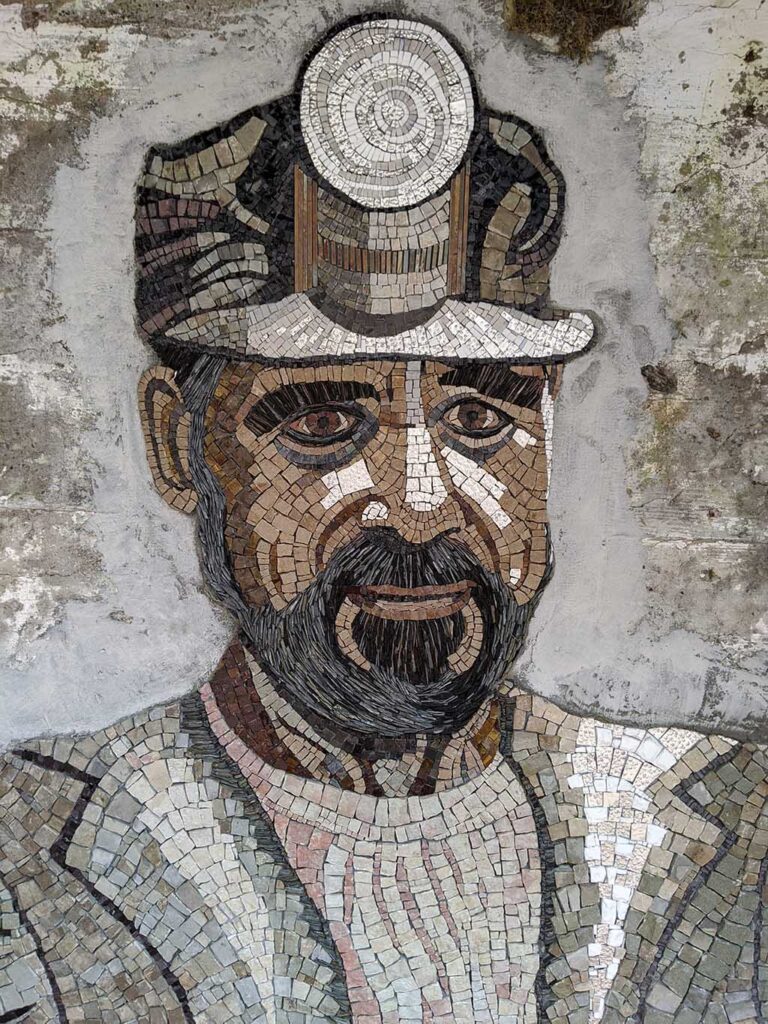
Look closely and you will see the lines of movement in every stone of Margy Cottingham’s portrait of the Anonymous Miner
My Perspective on Walking the Line
By nature, artists are meant to redefine boundaries and push others into uncomfortably new places, right? I agree. For me, pushing into new places works best when I am working within the line. My hands, brain, heart, and soul do their best when building a line that starts with one piece and reinvents itself with every piece that follows. I experience an absolute individual liberty within the confines of the line. I don’t know what’s coming around the next bend—and that’s the whole point.
Sandstone square, smalti sliver, marble rectangle, limestone circle—jumping into the rabbit hole of andamento, possibly never to come out again! As some may feel confined by following the rules of what makes mosaic language work, I experience complete liberation. When looking at the details of my work, you are seeing a human being tapping into a communication style that works better than speech or text for her. It is pure expression tempered through technique.
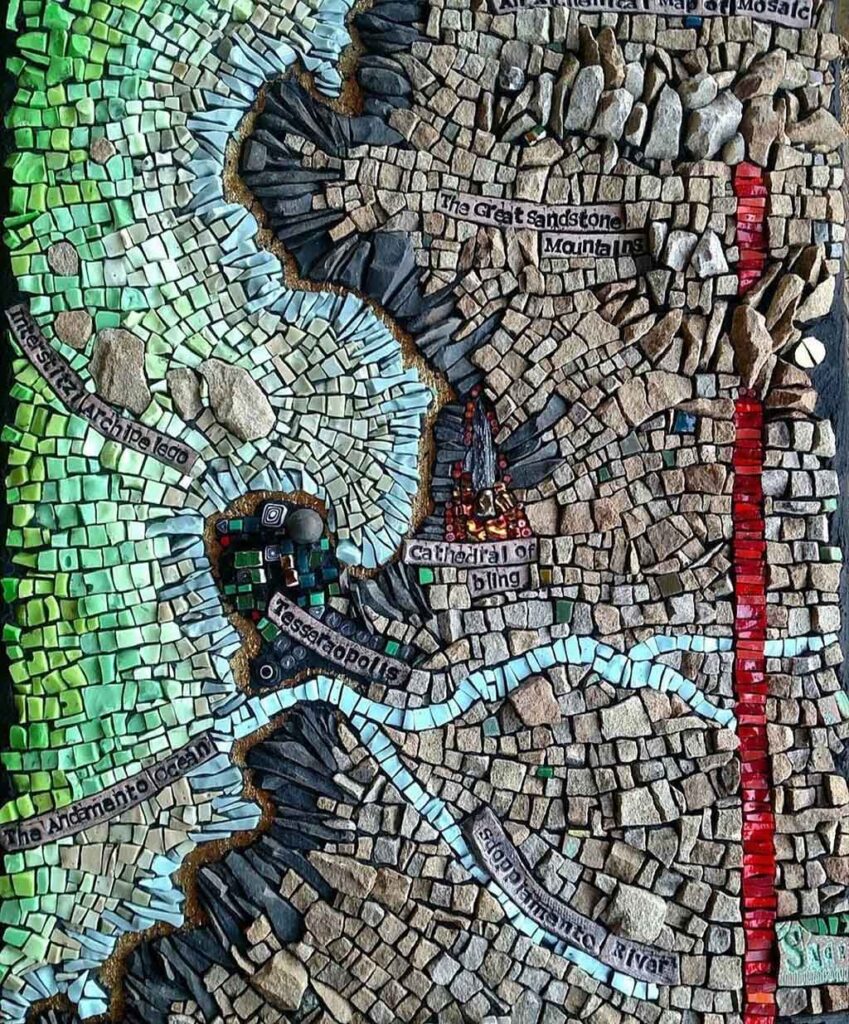
An Alchemical Map of Mosaic by Rachel Sager
I think of walking the line as an unanswerable question because there is no limit to what I can express with my lines. Completely abstract or highly realistic, my lines are me. If I am doing it right, my lines become an extension of my personality, my philosophy, and dare I say it? Yes, I do…my soul.
When I am building lines my brain switches to another frequency. I experience a peace that is missing in my other life. When I look for that next square of stone, there are no doubts and no second guessing. I am sure of my choice. And then I am sure of my next choice. I choose with confidence whether to set a keystone, a cube-like shape, a sliver, a rectangle, a circle, or even a triangle. I choose, mostly on an intuitive level, how to angle the shape of stone or glass into its bed of mortar. One way of describing this phenomenon is that I put the best of myself into my lines every day. My glaring imperfections in life contrast to the little bits of perfection that I can build onto the substrate.
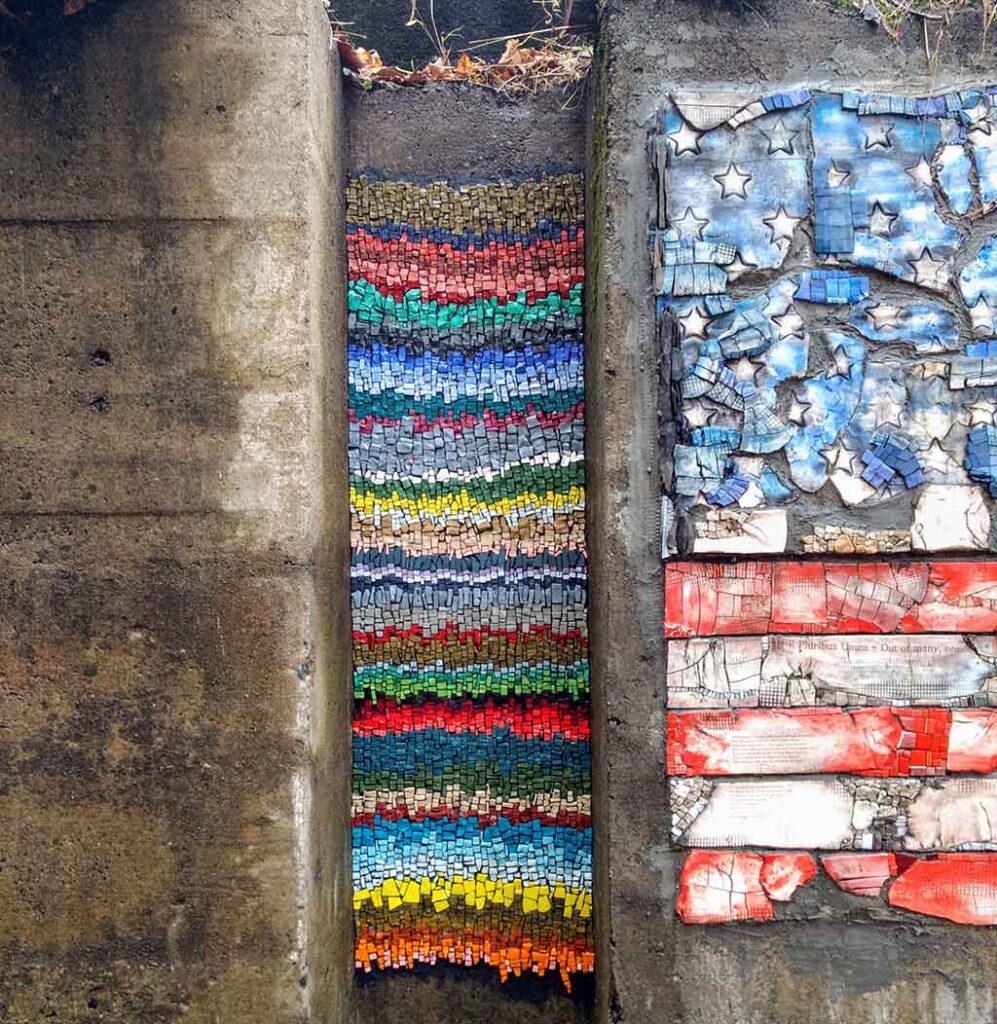
E Pluribus Unum at The Ruins by Rachel Sager and Deb Englebaugh.
Building the line makes me a better person.
The line builder is expressing herself within the line. She may be working in the confines of some boundaries, but those are secondary to her total immersion in building lines that stand on their own, lines that speak for themselves. Nothing makes this kind of mosaicist happier than making all those hundreds and thousands of choices, knowing that with each one she is expressing actions that are deeply intimate but also universally common.
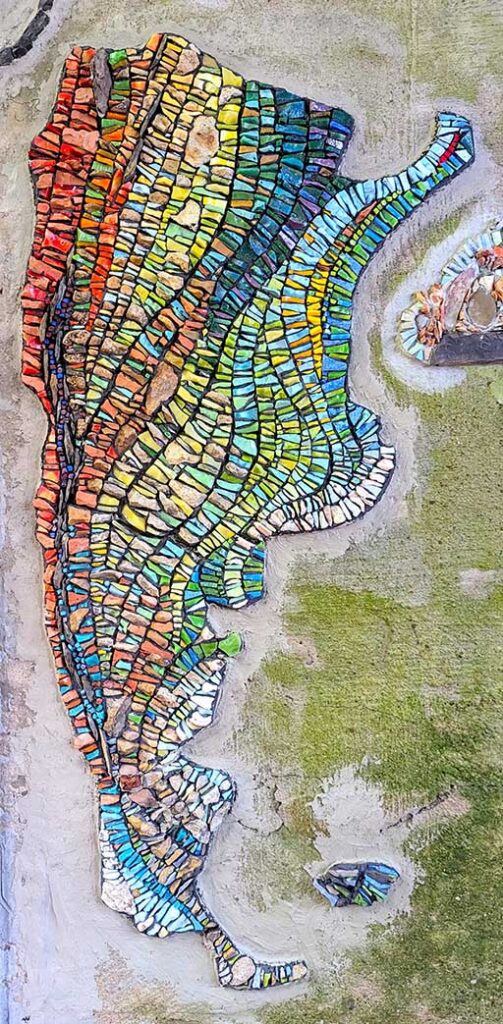
Argentinian artist Alejandra Martin representing her country as a map at The Ruins.
We can compare line building to architecture: creating little communities of tesserae that can theoretically be never-ending cities of communication, from a single tesserae house to a collection of tesserae villages, onward toward cityscapes, patchwork fields, layered landscapes, or even global swaths of expression.
Some mosaicists compare the line to writing. One word builds on the next. Each word should work to make the one before and after it stronger, or if not stronger, then at least more interesting. Every word (tessera) matters to the overall story (composition).
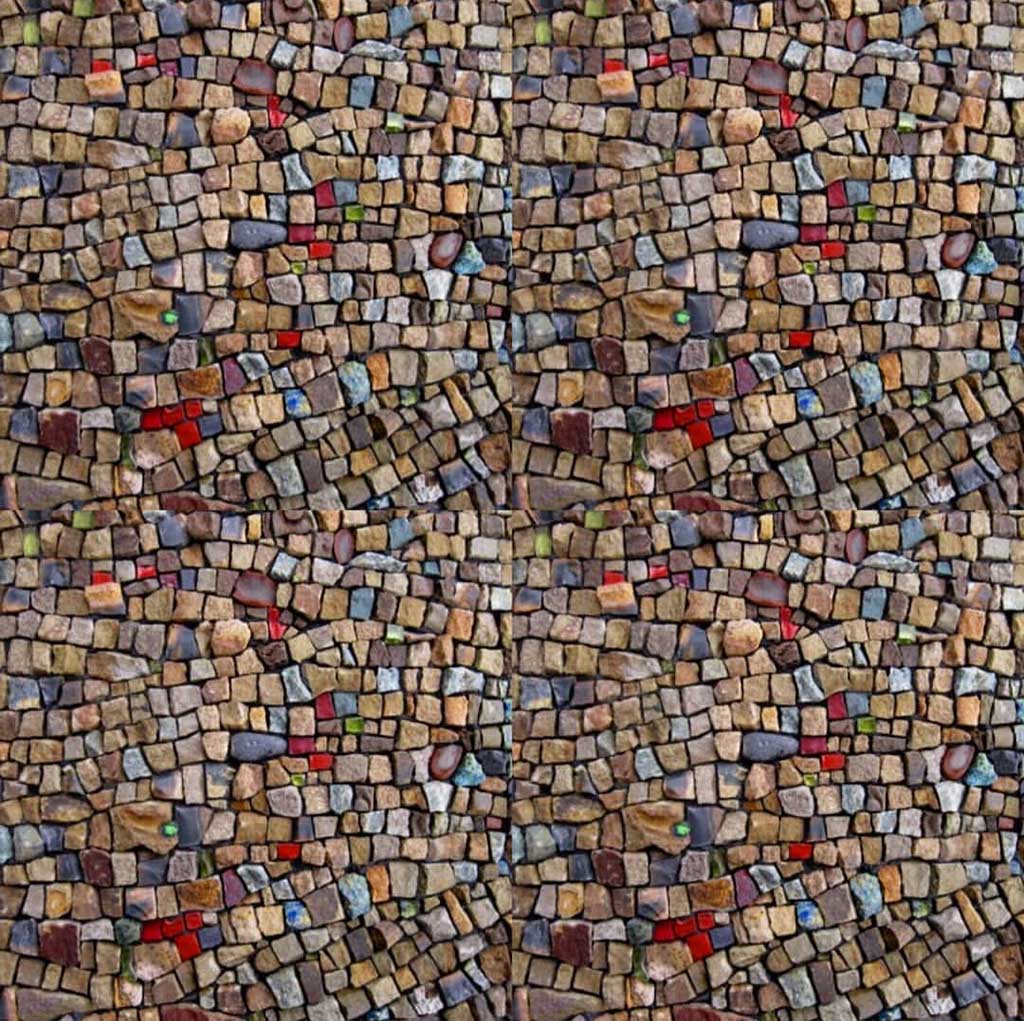
Can you see the lines? Sager Mosaics andamento
Some mosaicists are fluent in andamento. They don’t have to think as they choose the next right stone (word). Others are new to the language, and their newness shows in the awkward placement and shapes of their stone. But all the artists of The Ruins understand that walking the line is an adventure that should never really be over. Because with each piece set, we are walking the line as we build it.
One piece at a time.
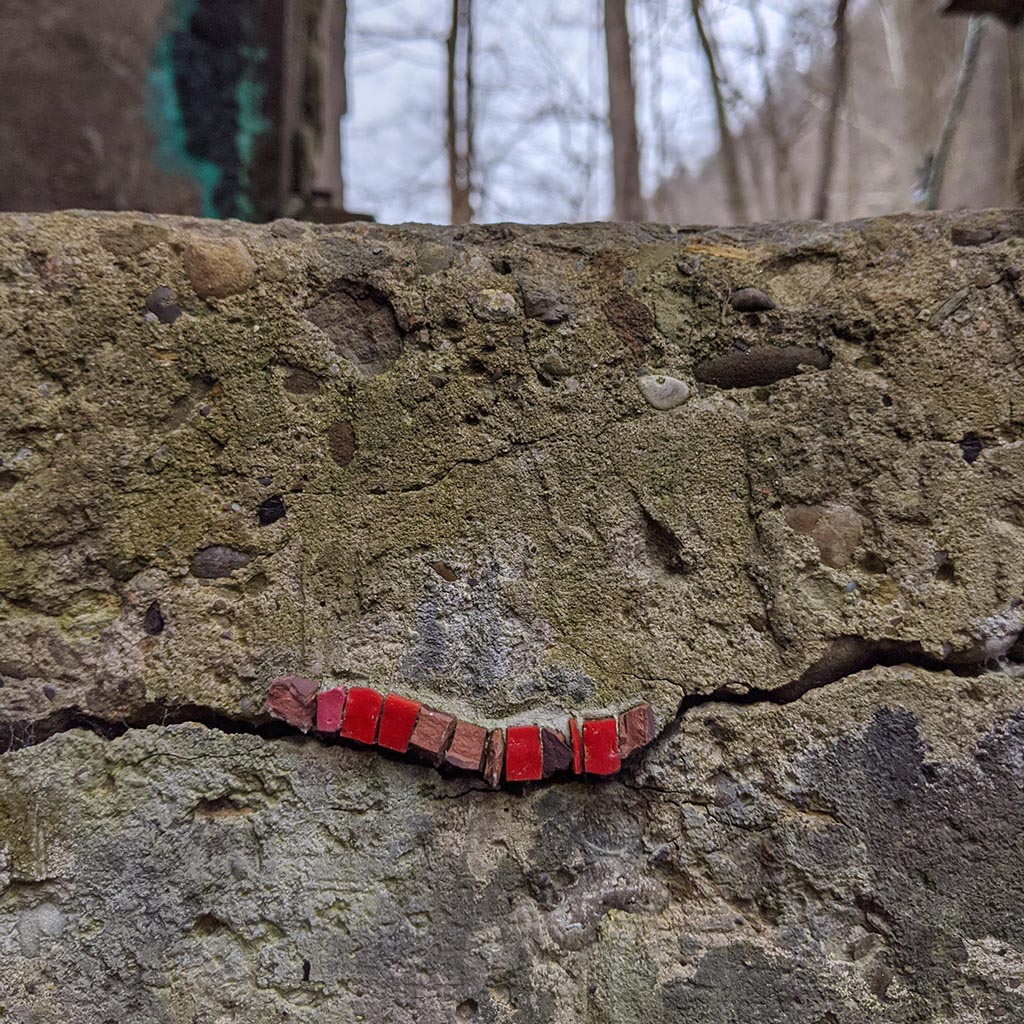
A very small line at The Ruins by Patty Darke Thomas
A Trio of Rules
This ends the trio of rules that help give The Ruins its form and function.
Without #1 of Honoring What Was, we would lose the stories of the past.
Without #2 of Building Relationships with Raw Material, we would lose the intimacy of connecting with the earth that is so important for artists who spend time here.
Without #3 of Walking the Line, we would lose the structure of an ancient language that, for the contemporary mosaicist, is just as important today as it was a thousand years ago.
The three rules work together to preserve what we already have while building on the mosaic of The Ruins future.
All images are courtesy of Rachel Sager.
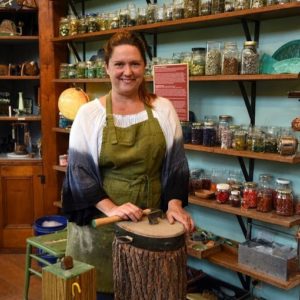 Rachel Sager, The Storytelling Mosaicist, has been making mosaic, writing about mosaic, speaking about mosaic, and teaching mosaic for over twenty years. Her signature forager and intuitive teaching styles have changed how mosaic is experienced and have helped build on the golden age that the art form is enjoying in these exciting decades.
Rachel Sager, The Storytelling Mosaicist, has been making mosaic, writing about mosaic, speaking about mosaic, and teaching mosaic for over twenty years. Her signature forager and intuitive teaching styles have changed how mosaic is experienced and have helped build on the golden age that the art form is enjoying in these exciting decades.
As the owner and creator of The Ruins Project and Sager Mosaics, Rachel lives and works as an Appalachian entrepreneur in the hills and hollows of her hometown just down the river from Pittsburgh in Fayette County.
The easiest (and most engaging) way to keep up with what’s happening at The Ruins is by subscribing to The Ruins Substack which is also where you can find the growing episodes of The Ruins Podcast, a collection of conversations that Rachel hosts with all walks of creative people who interact with her cathedral to coal.
She hopes you will join her in her quest to unearth optimism; some days with a shovel, some days with a hammer, and some days with a pen.
The Ruins is accessible through guided tours only. To make arrangements go to Book a Tour.
This is the second in a series by Rachel Sager. You can read Honor What Was, the first rule, and stay tuned for Rule #3 with more of The Ruins story.







